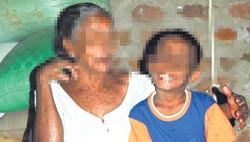
Sunday,
July 1, 2007
Vol.
42 - No 05
Then there were five, now there’s only himWhen parents stray there can be terrible consequences for the children. Kumudini Hettiarachchi reports on Lanka’s AIDS orphans
His father died first. His brother next, followed by his little sister. Two years ago he wept at his mother’s funeral. Now, though he may not know, he too is dying……..dying of AIDS. This 10-year-old going on 11 does not know how, where and whereof he has got AIDS. The only thing he knows is that he is in such excruciating pain that he wishes he could take something and join his family in the grave. He is an AIDS orphan not half a world away, but right here in Sri Lanka.
“ ‘Did you bring me rambutan? Why haven’t you brought me a toy?’ he asked me when I visited him last week,” said social worker Swarna de Silva, overwhelmed by emotion as she spoke about the families of the seven AIDS orphans, one whom has died, her organization, the Salvation Army, is supporting. The Salvation Army has taken under its wing 64 people living with HIV and their families, irrespective of their race and creed, supporting them not only nutritionally and looking into their health needs but also giving them that all essential love and care. The boy, living with a grandparent in the outstations, had been in hospital and was concerned that Ms. de Silva, the Territorial Coordinator for HIV/AIDS and Anti-Human Trafficking of the Salvation Army had not visited him. “I did visit him in hospital but he was sleeping and I didn’t want to wake him up,” she says.“He is only skin and bone now,” says Ms. de Silva with a tremor in her voice. The Sunday Times understands that 80% of children who get infected through mother-to-child transmission die within the first year because of the high HIV viral load in their system. Millions of children worldwide are losing one or both parents to AIDS (Acquired Immune Deficiency Syndrome) and the number is expected to reach a staggering 25 million by 2010, according to UNICEF estimates. Recent UNICEF data indicate that 14 million children under the age of 15 have lost one or both parents to AIDS, with HIV/AIDS continuing to cause unprecedented suffering among children for at least the next two decades if not longer. “Today’s prevalence levels will largely determine the number of orphans over the next decade. Because of the lag time between infection and death, the numbers of orphans will continue to increase even in countries where HIV infection rates are declining,” UNICEF has said. But in the hamlet where the little boy lives all is not gloom and doom. According to Ms. de Silva who spoke to The Sunday Times after addressing a media conference on ‘HIV Orphans’ on June 20, held in the run-up to the 8th International Congress on AIDS in Asia and the Pacific (ICAAP) to be held in Colombo in August, the village where the boy lives is a heartening example of how people have risen above the spectre of stigma and discrimination to support this family. “The authorities of the school to which this boy is going |

